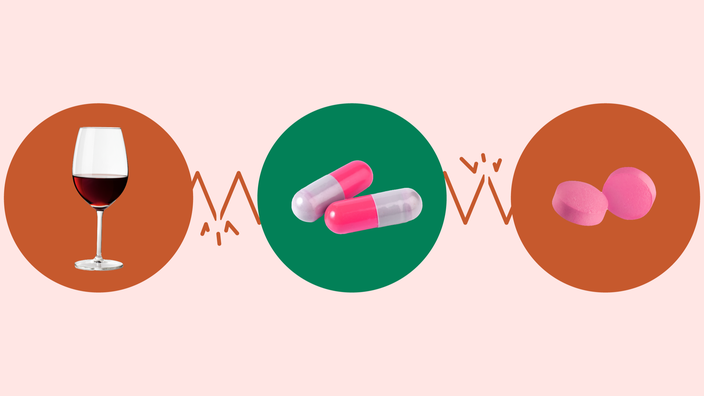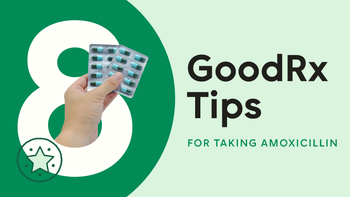
7 Amoxicillin Interactions You Should Know About
Key takeaways:
Amoxicillin is a penicillin antibiotic that’s commonly prescribed for bacterial infections. It’s available with a prescription from your healthcare provider.
Amoxicillin can interact with medications like warfarin, allopurinol, and probenecid. It may also interact with alcohol and some live vaccines.
Make sure to provide an updated medication list to your healthcare provider and pharmacist. This will help them check for amoxicillin interactions.
Access savings on related medications
Table of contents

At some point, you or a loved one have likely received a prescription for amoxicillin. It’s a common, low-cost penicillin antibiotic that’s available at pharmacies across the U.S. It treats bacterial infections ranging from skin infections to infections of the ears, nose, and throat.
Amoxicillin is also considered safe to take. However, interactions with other medications are still possible. Some interactions can worsen amoxicillin’s side effects, while others may impact the effectiveness of the interacting medication. It’s helpful to be aware of possible amoxicillin interactions before you start taking it. We’ll discuss seven of them below.
1. Warfarin
Warfarin (Coumadin, Jantoven) is a blood thinner that treats and prevents blood clots. If you take warfarin, your healthcare provider likely warned you about possible interactions with food, medications, and even supplements. Some interactions enhance warfarin’s effects, which worsens the risk of easy bleeding or bruising. Others make warfarin less effective, which raises the risk of blood clots.
Search and compare options
Many antibiotics, including amoxicillin, might increase the risk of bleeding with warfarin. As a precaution, your healthcare provider might check your blood work more often while you’re taking the combination. Based on test results, they might adjust your warfarin dose to help prevent side effects.
Listening to your body is another good precaution to take. Watch for any signs of unusual bruising or bleeding when taking warfarin. This could include black or red stools, bleeding gums, or unexplained nosebleeds. Report these to your healthcare provider if they happen.
2. Allopurinol
Allopurinol (Zyloprim) is a common medication for gout. But allopurinol has a risk of causing skin rashes, which can range from mild to severe. Skin rashes are also a possible side effect of amoxicillin. If you take them together, there’s a bigger risk of developing skin rashes.
In rare cases, this combination could lead to a dangerous condition called drug reaction with eosinophilia and systemic symptoms (DRESS) syndrome. This is a severe allergic reaction to a medication. Possible symptoms include fever, a widespread peeling rash, and swollen lymph nodes.
If you notice a skin rash of any severity while taking allopurinol, stop taking the medication and contact your healthcare provider for advice. You should get medical help right away if you develop a blistering skin rash with a fever. This could be a sign of a severe skin reaction, including DRESS syndrome.
Skin rashes have another layer of complexity. Some amoxicillin rashes may be related to a penicillin allergy. Call 911 or seek emergency help if you notice symptoms like hives, trouble breathing, or swelling in the face, tongue, or throat.
3. Probenecid
Probenecid is another gout medication that can interact with amoxicillin. It makes amoxicillin stick around for longer in your body.
If you take probenecid and amoxicillin together, there’s a higher risk of developing amoxicillin side effects, such as new or worsening nausea, vomiting, or diarrhea. These symptoms can be bothersome, so make sure to reach out to your healthcare provider if they feel intense or get worse at any point.
This interaction isn’t always bad, though. This interaction is beneficial in certain situations. These medications are sometimes prescribed together to treat sexually transmitted infections, like gonorrhea.
4. Certain antibiotics
Amoxicillin doesn’t get along with all antibiotics. The significance of the interaction isn’t clear, but it may interact with antibiotics like sulfamethoxazole / trimethoprim (Bactim), tetracyclines (tetracycline, doxycycline), and macrolides (azithromycin, clarithromycin). These medications could make amoxicillin less effective. Lab data suggests this could lead to an undertreated infection, but this hasn’t been confirmed.
Thankfully, this interaction is pretty easy to avoid. Your healthcare provider likely won’t prescribe these antibiotics at the same time. But if they do, they can tell you about the pros and cons of taking them together.
5. Certain live vaccines
Vaccines help our bodies learn to fight infections before we come across the viruses or bacteria that cause them. But many antibiotics — including amoxicillin — can make some live vaccines less effective. Top ones to keep in mind are the live cholera vaccine (Vaxchora) and the live typhoid (Vivotif) vaccine. These are vaccines you might receive before you travel to certain countries.
If you plan to get vaccines like these in the future, your healthcare provider may recommend separating them from your antibiotic. These are the general guidelines to follow:
Vaxchora: Separate Vaxchora and your last amoxicillin dose by at least 14 days (2 weeks).
Vivotif: Separate Vivotif and your last amoxicillin dose by at least 72 hours (3 days).
Of note: Not all live vaccines interact with amoxicillin. Only a few are affected. This interaction is also not a concern for other types of vaccines, including COVID-19 vaccines and flu shots.
6. Alcohol
“Can I drink alcohol with my antibiotic?” This is a common question that pharmacists hear. For good reason, too. Mixing some antibiotics with alcohol may cause unpleasant, and even dangerous, side effects. It can also make it harder for antibiotics to do their job.
Amoxicillin alone can cause side effects like nausea, vomiting, and diarrhea. But alcohol can also cause these side effects. When they’re combined, they may feel more intense. What’s more, alcohol can weaken your immune system. This can make it harder for amoxicillin and your immune system to fight your infection.
Because of these risks, it’s best to not mix alcohol with amoxicillin. But if you’re interested in raising your glass, talk to your healthcare provider to see if it's safe to drink in moderation while taking amoxicillin.
7. Birth control pills
It’s a common myth that all antibiotics make birth control pills less effective. This is only true for some antibiotics, like rifampin and rifabutin. These rifamycin antibiotics can lower the amount of hormones that your body absorbs from your birth control.
This isn’t the case for antibiotics like amoxicillin. If you’re taking amoxicillin, it shouldn’t interfere with your birth control. Studies show that non-rifamycin antibiotics don’t lower the effectiveness of birth control.
Still, if you’re worried about pregnancy while taking antibiotics, there are other precautions you can take. Talk to your healthcare provider about other birth control options that may fit your lifestyle, such as condoms.
Can you take Tylenol with amoxicillin?
Yes, it’s OK to take Tylenol (acetaminophen) with amoxicillin. There aren’t any interactions between the two medications. If your infection is causing pain or a fever, Tylenol is one option to help calm your symptoms. Kids and adults can both take it.
But keep in mind that Tylenol isn’t safe for everyone to take. If you have liver problems, have a high alcohol intake, or are fasting, ask your healthcare provider if taking Tylenol is a good idea. You may be told to skip it or take a lower dose.
What about taking ibuprofen with amoxicillin?
Yes, you can also take ibuprofen (Advil, Motrin) with amoxicillin. If you need pain or fever relief, you can turn to ibuprofen. You can also alternate back and forth between Tylenol and ibuprofen since they work differently. However, if you have kidney problems, ask your healthcare provider if ibuprofen is safe for you to take.
How can I avoid or manage potential interactions with amoxicillin?
Make sure you give your healthcare provider and pharmacist your most current medication list. The list should include all prescription and over-the-counter medications you take. Don’t forget vitamins and herbal supplements, either. This information will help them prevent and manage interactions.
This is especially important if you have medications from multiple healthcare providers or you fill medications at more than one pharmacy. One person might not be aware that you’re taking medication from somewhere else.
When should I contact my healthcare provider about an amoxicillin interaction?
Nausea, vomiting, and diarrhea are common side effects of amoxicillin. They’re not nice to deal with, but they should go away after stopping the medication.
If side effects like these become concerning or don’t go away, contact your healthcare provider as soon as you can. They can help you manage your symptoms. And if your symptoms feel severe, don’t hesitate to call for emergency help instead.
The bottom line
Amoxicillin interacts with medications like warfarin, allopurinol, and probenecid. It can also cause trouble with alcohol and interact with live vaccines for cholera and typhoid. To prevent interactions, make sure to give your healthcare provider and pharmacist your most current medication list.
Why trust our experts?



References
American Health Packaging. (2022). Allopurinol [package insert].
A-S Medication Solutions. (2022). Amoxicillin [package insert].
Baillargeon, J., et al. (2012). Concurrent use of warfarin and antibiotics and the risk of bleeding in older adults. American Journal of Medicine.
Bryant Ranch Prepack. (2021). Probenecid [package insert].
Centers for Disease Control and Prevention. (2020). Outpatient antibiotic prescriptions.
Centers for Disease Control and Prevention. (2022). Travel vaccines.
Fredj, N. B., et al. (2010). Hypersensitivity to amoxicillin after drug rash with eosinophilia and systemic symptoms (DRESS) to carbamazepine and allopurinol: a possible co-sensitization. British Journal of Clinical Pharmacology.
Kroger, A. T., et al. (2021). Vaccination & immunoprophylaxis: General recommendations. CDC Yellow Book.
Simmons, K. B., et al. (2018). Drug interactions between non-rifamycin antibiotics and hormonal contraception: a systematic review. American Journal of Obstetrics & Gynecology.
Youngster, I., et al. (2019). Interactions between travel vaccines & drugs. CDC Yellow Book.
Was this page helpful?
Related Articles
Browse medications
View AllResearch prescriptions and over-the-counter medications from A to Z, compare drug prices, and start saving.



























